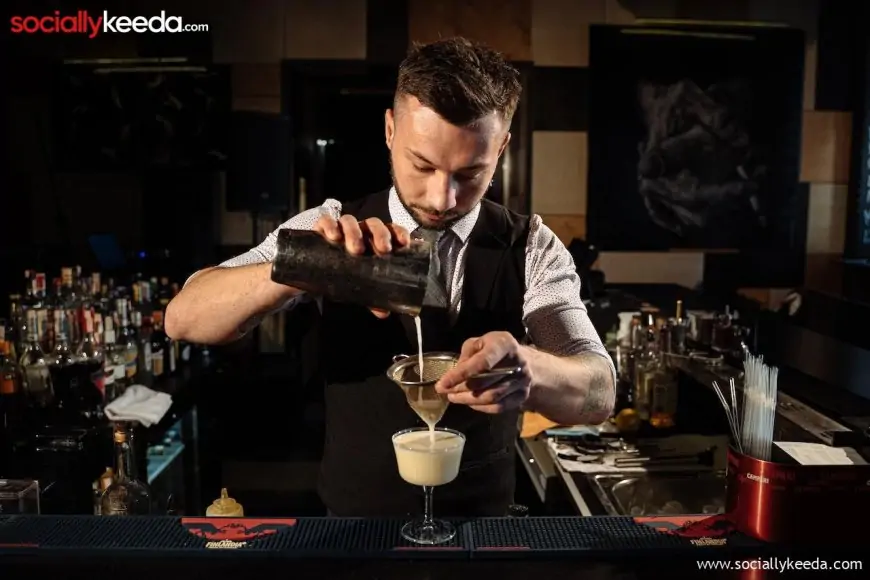If you're interested in bartending, there's no better time to get started than now. With the rise of craft cocktails and the growing popularity of mixology, the demand for skilled bartenders is higher than ever before.
But before you start shaking up drinks, you'll need to learn the basics of mixology. Below, we'll cover the essential tools and techniques you'll need to get started with bartending. We'll also share classic cocktail recipes for beginners, tips for creating your own cocktails, and advice on how to improve your bartending skills.
Essential Bartending Tools & Equipment
To get started with bartending, you'll need to invest in some basic tools and equipment. Here are the essentials:
- Shaker - A shaker is used to mix and chill cocktails. There are two main types of shakers: a Boston shaker (which consists of a metal tin and a pint glass or two metal tin cups) and a cobbler shaker (which has a built-in strainer and a lid).
- Jigger - A jigger is a small measuring cup used to measure the precise amounts of liquids needed for a cocktail.
- Strainer - A strainer is used to strain out ice and any other solid ingredients when pouring a drink into a glass.
- Bar Spoon - A bar spoon is used to stir cocktails and measure syrups.
- Muddler - A muddler is used to crush fruits, herbs, and other ingredients to extract their flavor.
- Glassware - There are a variety of different glasses used for different types of drinks. The most common types of glassware are the highball glass, rocks glass, Martini glass, and coupe glass.
- Ice Bucket - An ice bucket is used to store ice for drinks.
When purchasing equipment, it's important to choose high-quality items that are durable and easy to clean. You can find bartending tools and equipment at most kitchen supply stores or online retailers.
Basic Mixology Techniques
Once you have your tools and equipment, it's time to learn the basics of mixology. Here are some essential techniques:
How To Measure & Pour Ingredients
When measuring and pouring ingredients, it's important to use a jigger to get precise amounts. A jigger typically measures 1 oz and 1.5 oz.
Stirring, Shaking, & Straining
Different cocktails require different mixing techniques. For example, a Martini is typically stirred, while a Margarita is shaken. A Hawthorne strainer is used for a Boston shaker, while a julep strainer is used for a mixing glass.
Garnishes
Garnishes are used to enhance the flavor and appearance of a drink. Common garnishes include citrus peels, olives, and cocktail cherries.
Classic Cocktail Recipes For Beginners
Now that you know the basics, it's time to start making some cocktails. Here are some classic recipes that are perfect for beginners:
- Margarita - Combine 2 oz tequila, 1 oz lime juice, and 1 oz triple sec in a shaker with ice. Shake and strain into a salt-rimmed glass filled with ice.
- Martini - Combine 2.5 oz gin and 0.5 oz dry vermouth in a mixing glass with ice. Stir and strain into a chilled Martini glass or coupe glass.
- Old Fashioned - Muddle a sugar cube, 2 dashes of bitters, and a splash of water in a rocks glass. Add ice and 2 oz of bourbon or rye whiskey. Stir and garnish with an orange peel and cherry.
Creating Your Own Cocktails
Once you've mastered the classic cocktail recipes, it's time to start experimenting with your own creations. Here are some tips for creating your own cocktails:
- Start With A Base Spirit - Choose a base spirit like gin, vodka, or rum, and build your cocktail around that.
- Add Other Liquors - Choose other liquors that complement the base spirit, like triple sec, vermouth, or bitters.
- Experiment With Mixers - Experiment with different mixers, like juices, sodas, or syrups, to find a flavor profile that you like.
- Consider The Season - Use ingredients that are in season to create cocktails that are fresh and flavorful.
- Taste As You Go - Taste your cocktail as you add ingredients to ensure that the flavors are balanced.
Building Your Bartending Skills
To improve your bartending skills, there are a variety of resources available. Here are some options:
- Mixology Courses - There are many mixology courses available, both online and in-person. These courses can teach you more advanced techniques and allow you to practice your skills.
- Mixology Classes - Many bars and restaurants offer mixology classes where you can learn from experienced bartenders and practice making cocktails.
- Practice At Home - The best way to improve your bartending skills is to practice making cocktails at home. Invite friends over and experiment with different recipes.
- Learn From Experienced Bartenders - Talk to experienced bartenders and ask for their advice on improving your skills. They may have tips on techniques or recommendations for new ingredients to try.
- Cocktail Books - Check out cocktail books that not only give you recipes but also explore flavor combinations and mixology techniques.
Bartending Etiquette: How To Be A Great Bartender
Being a great bartender is not just about making great drinks. It's also about providing a great customer experience. Here are some tips for bartending etiquette that will help you provide excellent customer service:
- Greet Your Customers - When a customer approaches the bar, greet them with a smile and ask them what they would like to drink.
- Be Attentive - Pay attention to your customers and anticipate their needs. If a customer is running low on their drink, offer to refill it. If they look like they're in a hurry, prioritize their order.
- Keep Your Bar Clean - A clean bar is essential to creating a positive customer experience. Keep your bar free from clutter, and clean up spills promptly.
- Know Your Menu - Be familiar with your bar's menu and be able to recommend drinks to customers who are unsure what they want.
- Engage Your Customers - Strike up a conversation with your customers and get to know them. This will create a friendly and welcoming atmosphere in your bar.
- Handle Complaints Gracefully - If a customer is unhappy with their drink or service, handle their complaint gracefully. Listen to their concerns, and try to find a solution that satisfies them.
- Thank Your Customers - When a customer leaves the bar, thank them for their business and invite them to come back again.
Bartending is a skill that requires practice, patience, and a commitment to providing excellent customer service. By investing in the right tools and equipment, learning the basics of mixology, and mastering the art of bartending etiquette, you can become a skilled bartender and create a great customer experience.
Remember to take mixology courses online or attend mixology classes in-person, seek advice from professional bartenders, read cocktail books for information, and practice at home to improve your skills. With dedication and preparation, you can create delicious cocktails and provide excellent customer service that will keep your customers coming back for more.






![[WATCH VIDEO] Sophie Rain and sister Sierra Rain as Black Spiderman goes viral [WATCH VIDEO] Sophie Rain and sister Sierra Rain as Black Spiderman goes viral](https://www.sociallykeeda.com/uploads/images/202403/image_140x98_660976c59cce0.webp)






![[FULL WATCH VIDEO] Will Levis And Gia Duddy Leak Video Viral On Social Media [FULL WATCH VIDEO] Will Levis And Gia Duddy Leak Video Viral On Social Media](https://www.sociallykeeda.com/uploads/images/202405/image_140x98_6651e7ae8038d.webp)

